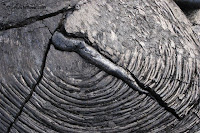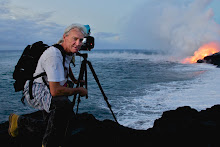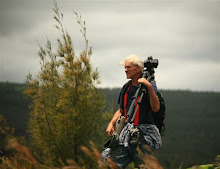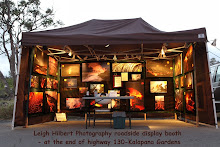EDIT NOTICE - 2:00 PM Wednesday the 11th. 2009-- The Civil Defense Lava Viewing area will be closed today due to unfavorable wind directions that are causing the ocean entry toxic fumes to lie back over the viewing area.
Early this morning I could see the top of Mauna Kea – still snowless even as it’s name means White Mountain in Hawaiian. Official forecasters are still warning of very strong winds and possible heavy snow up there. A large counter-clockwise spiraling low-pressure system pushing down over the Hawaiian Islands from the north, whose center now lies close to Kauai, remains almost stationary. This low contains lots of upper level cold air. The cold air creates troughs that suck heavy, warm, moist air in from the south of us. It is this mix that can create large thunderheads and dump heavy rain on the islands, or snow on the tops of our two highest volcanoes – and – create heavy rain clouds out of what were only minutes before, clear blue skies.
By complete chance, this is exactly what is happening as I type!— mostly clear blue skies were predominant as I looked out in all directions from my little weather-tower of a house less than twenty minutes ago… Suddenly, starting from mauka side, the sky thickened with darkening purple-black clouds and began pouring rain while the morning sun continued shinning from the side…. I must be inside a rainbow right now!! Have you ever been inside? Sometimes you can actually see the sparkling iridescent mist drops of colors shimmering in the air all around you. While we’re on the subject, did you know that with a double rainbow the color patterns are mirrored/reversed from each other?

Lava Flow:
I was not out there to witness the lava activity first hand this time, but my reporters stated that the previously visible surface flows of lava could not easily be spotted out on the active flow fields to the west of County viewing areas. They also reported a weakened ocean entry activity at Waikupanaha, but it was still billowing up a steam plume and glowing lava colors after dark
The weaker lava activity can likely but attributed to a continuing drop in magma pressure under the volcano, as registered on USGS sensors and as shown on the graph below. The up & down pressure has been stuck in that pattern for six straight days, which is fairly unusual.

Friends have been reporting some decent surf sessions on our southeast shores…. I’m missing out; been too busy to make it out there… Geez, I can even hear a nice surf pounding in right now!





























































